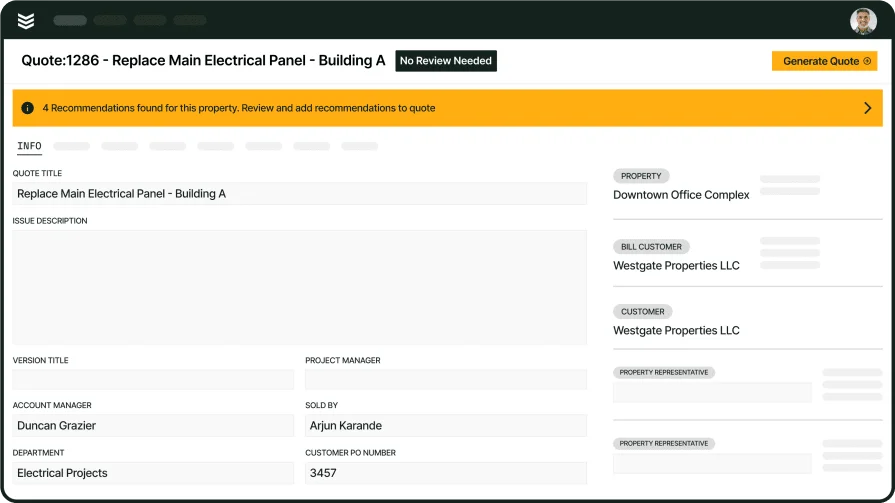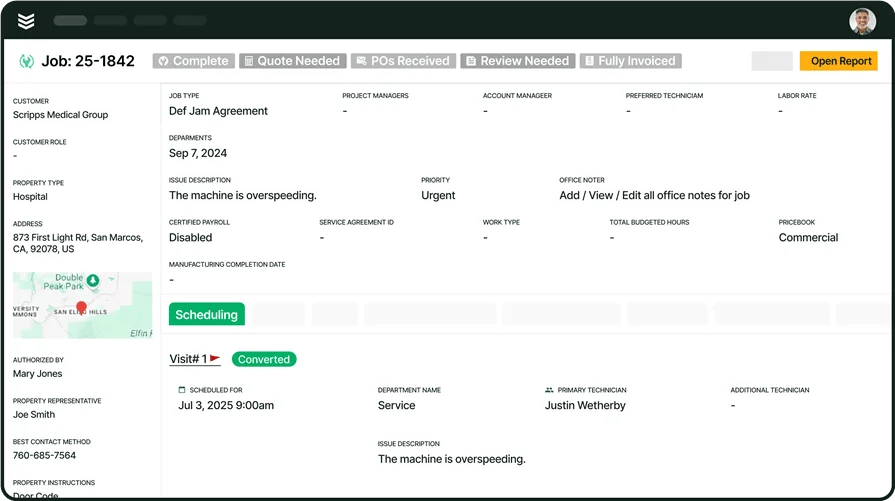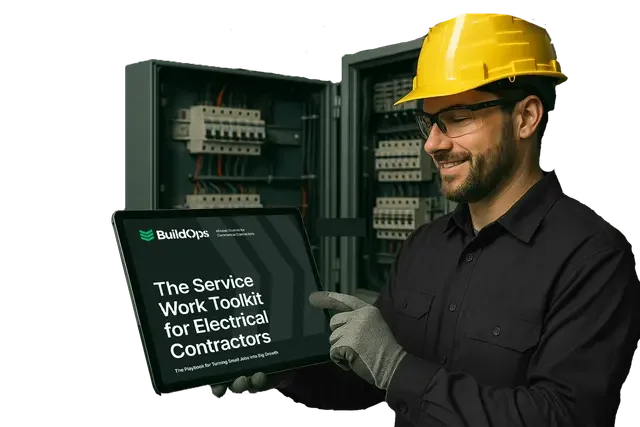Running electrical jobs means juggling permits, tight timelines, and keeping crews aligned across shifting job sites. When you're handling installs, service calls, and inspections all at once, you need a system that holds it all together. That’s where electrical contractor project management software steps in—keeping your team on the same page, your schedule tight, and your costs in check.
The demands of the electrical industry call for tools made to manage the real-life complexity of electrical projects—from quoting and scheduling to tracking progress and wrapping up the punch list. This guide walks you through how to choose the right system, what features to look for, and which tools stand out depending on the kind of work you do. Here’s what we’ll cover:
- Choosing an electrical contractor project management software
- 6 key electrical contractor project management software features
- Best for commercial
- Best for residential
- Best for general contractors
- Other notable project management tools for electrical contractors
- 7 benefits of using electrical contractor project management software
- 4 important project management software FAQs answered for electrical contractors
Before you start comparing platforms, it’s worth slowing down and asking the tough questions. Not every electrical contractor project management software works the same—and not every one will work for your business. What kind of jobs are you bidding on? How big is your team? Are you tracking change orders, RFIs, and inspections manually? The answers to these will shape what features you need and what kind of system fits best.
Choosing an electrical contractor project management software
No two electrical contracting operations look the same. Some crews run high-volume service calls. Others juggle big commercial builds with multiple subs. The key is making sure your tools match your workflow. Before committing to electrical contractor project management software, ask yourself what problems you’re actually trying to solve. You’re not buying features—you’re investing in fewer headaches. Here’s where to start:
- Job types and volume - Are you managing high volumes of service tickets, or longer-term projects with multiple phases? Do you need something that handles both commercial and residential work without slowing you down? How often are you coordinating multiple crews at once?
- Field-to-office communication - Can your field teams easily update the office in real time? Are change orders, job updates, and delays clearly documented and shared automatically? How much time does your team waste tracking down basic info?
- Scheduling and resource allocation - How confident are you that every tech is scheduled efficiently? Are materials and equipment getting where they need to be—on time? Do you have a centralized place to view labor availability, truck routes, and job timelines?
- Budgeting and billing - Are bids aligned with actual costs by the time a job wraps? How easy is it to track T&M work, change orders, and purchase orders? Is your billing team chasing down paperwork to send invoices?
- Features - Does the software support submittals, RFIs, change orders, and daily logs natively? Will your team actually use it, or is it too complex to bother with? Can the system integrate with the other tools you already use?
Next, let’s break down the key features that matter most in electrical project management software—and how they show up in the best electrical project management software on the market.
6 key electrical contractor project management software features
When your crew is balancing multiple jobs, last-minute changes, and customer expectations, small missteps can turn into big delays. The right electrical contractor project management software keeps everything moving—quotes, schedules, crew updates, billing, and more—without the chaos. Here are six essential features to look for.
1. Quoting and estimating
You need to generate accurate estimates fast—without going back and forth between spreadsheets and handwritten notes. A quoting tool tied into your project pipeline lets you track costs, markups, and scope changes all in one place. You can revise in real time and convert quotes into active jobs without duplication or data loss.
For example, let’s say a customer wants to upgrade from basic to smart panels midway through the job. With the right quoting software for electrical contractors, your team can update the estimate on the fly, track the change order, and send an updated proposal before leaving the site.
2. Scheduling
Coordinating techs across job sites is one thing—making sure the right tech shows up with the right skills and tools is another. That’s where drag-and-drop scheduling comes in. You can assign based on skill set, availability, or proximity, and quickly adjust when emergencies hit.
Let’s say two of your electricians are out sick, and you’ve got a tenant improvement job that can’t wait. With smart field service scheduling tools for electrical teams, you can reassign tasks with a few clicks, notify the field instantly, and keep the job moving without phone tag.
3. Dispatching
More than just sending people to a job site, dispatching in electrical work often means coordinating specialty techs, permits, and customer access windows. Advanced dispatch software gives your team visibility into routes, ETAs, and field status so no time is wasted.
Now picture this—your tech finishes a panel upgrade early, but another nearby job’s behind. A smart electrical field service dispatch software solution lets you reroute him straight from the field, update the schedule, and notify the customer—all before the office even picks up the phone.
4. Technician mobile access
It’s not enough for the office to be organized—your techs need access to the same info in real time. With mobile apps designed for field use, techs can view job details, upload photos, complete forms, and send updates back to the office without waiting.
Let’s say your electrician runs into a surprise conduit reroute. Instead of phoning it in or scribbling on a clipboard, they can log it instantly using a technician mobile app, attach a photo, and move on. No guesswork, no delays, no missed billables.
5. Invoicing and payments
Billing delays eat into cash flow. With built-in invoicing and payment processing, you can go from job complete to paid faster. Look for tools that auto-populate invoices from logged work and let customers pay digitally on the spot.
Say you’ve just finished a small commercial buildout. The job’s wrapped, but accounting’s still waiting on paper timecards. With automated invoicing and payment features baked into your workflow, the office can generate an invoice instantly, and the client can pay online—same day.
6. Reporting and insights
Without clear reporting, you’re guessing where time and money are going. Look for tools that offer real-time dashboards, job costing, and team performance tracking—so you can make decisions based on facts, not gut checks.
Think about the end of the quarter. You want to know which crews hit their deadlines, where profit margins dipped, and which job types cost the most rework. With strong reporting and analytics features for electrical contractors, you can pull that data in seconds and use it to guide your next move—not dig through spreadsheets for hours.

Explore our project management suite
BuildOps has electrical contractor-built tools to keep jobs organized and on track.
Other valuable features to look for in an electrical contractor project management software
Once you’ve covered the essentials—quoting, scheduling, dispatching, mobile access, invoicing, and reporting—it’s time to look at the features that add polish. These extras may not be mission-critical, but they can make a big difference in how efficiently your electrical business runs day to day.
- Fleet tracking: With fleet management tools, you can monitor vehicle usage, fuel levels, and maintenance needs in one place. It’s especially useful for shops with multiple service vehicles. This gives your dispatchers more visibility and reduces downtime due to unexpected breakdowns.
- Customer management: A reliable CRM platform lets you track customer details, site history, and open jobs without relying on sticky notes or disconnected spreadsheets. It helps your team deliver better service and close follow-ups faster.
- Time tracking: Having digital time tracking tools cuts down on payroll errors and gives you more accurate labor costing. Crew members can log time directly from the field, reducing timecard delays and helping your PMs keep tabs on productivity.
Choosing the best electrical project management software setup doesn’t mean loading up on every feature—it means picking the ones that move the needle for your team. Next, let’s compare the top choices out there and see which solution works best for commercial electrical contractors.
Best for commercial: BuildOps
BuildOps is designed specifically for commercial electrical contractors juggling complex timelines, detailed estimates, and large teams. It connects quoting, scheduling, dispatching, and billing into one seamless system that helps you manage the chaos without losing track of the job.
How pricing works: BuildOps offers custom pricing based on team size, feature scope, and business needs.
Features beyond project management: You’ll get tools like real-time job costing, detailed customer records, technician mobile access, and built-in service agreement tracking—features that save office and field teams hours each week.
What sets it apart for commercial: Every feature supports the real-world demands of commercial electrical jobs, from quoting multi-phase builds to tracking job costs across multiple crews.

Curious how BuildOps works?
Find out how we keep office and field teams perfectly in sync for any job.
Best for residential: Fieldwire
Image Source: Fieldwire
Fieldwire is a field-focused project management tool used by residential contractors to manage punch lists, plan markups, and day-to-day crew coordination. Its clean interface and mobile-first setup make it approachable for smaller teams with straightforward workflows. However, it lacks deeper features for financial tracking and complex job costing, which limits it for commercial electrical work.
How pricing works: Fieldwire offers a free tier with basic tools and paid plans starting at around $39 per user per month.
Features beyond project management: Includes mobile access for plan viewing, photo documentation, and team messaging. It’s helpful for keeping small residential jobs organized but not built for scaling across large teams.
What sets it apart for residential: Lightweight and easy to adopt for residential shops needing a fast way to assign tasks and track field updates.
Best for general contractors: Procore
Image Source: Procore
Procore is a comprehensive construction management platform aimed at general contractors who need to manage complex builds across trades. It covers everything from financials to field collaboration and is known for its broad functionality. That said, its size and complexity can be overkill for smaller electrical contractors and requires significant onboarding.
How pricing works: Procore doesn’t publish pricing but is known to operate on custom quotes that can scale significantly with usage.
Features beyond project management: Offers tools for document management, RFI tracking, submittals, change order management, and financial oversight.
What sets it apart for general contractors: It’s a robust all-in-one platform best suited for GCs managing multi-trade workflows and large-scale project coordination.
Other notable project management tools for electrical contractors
Not every electrical contractor needs a heavy-duty platform. Depending on your job types and crew size, a leaner project management solution might do the trick. Here are five more options worth considering—especially if you're looking for something specific like cost tracking, change order handling, or simplified scheduling.
1. Trimble
Image Source: Trimble Accubid
Trimble offers a solution focused on cost control and budget tracking, with solid tools for managing RFIs, drawings, and submittals. It’s a good option for contractors who need to stay on top of change orders and document management but don’t need end-to-end field operations tools. That said, it’s not ideal for electrical contractors who need mobile-first dispatching or job costing tied to technician activity.
How pricing works: Trimble uses tiered pricing, but most commercial features are locked behind higher-cost enterprise plans.
Features beyond project management: Includes drawing management, submittal tracking, budgeting modules, and document control tools.
What sets it apart: Trimble is strong on documentation workflows, making it useful for shops that need to keep tight tabs on RFIs and plan versions.
2. Knowify
Image Source: Knowify
Knowify is built for small contractors who want better visibility into job costing and real-time performance. It includes estimating, invoicing, scheduling, and contract management in one place. While helpful for tracking budgets, Knowify lacks deeper dispatch or field reporting tools, which can limit its use on larger or multi-crew jobs.
How pricing works: Paid plans start around $149/month, with costs increasing depending on user count and advanced feature access.
Features beyond project management: Offers time tracking, estimate templates, contract compliance tools, and financial dashboards.
What sets it apart: Knowify’s strength is in helping smaller electrical shops get a better handle on job profitability.
3. eSUB
Image Source: eSUB
eSUB is designed specifically for subcontractors, including electrical trades, with tools for daily reports, RFIs, and labor tracking. Its layout mirrors the paperwork-heavy nature of specialty contracting, which is great for documentation but less intuitive for crews who live in the field. It may feel dated or clunky for teams that rely on mobile-first coordination.
How pricing works: Plans start around $49/user/month, with customized enterprise pricing available.
Features beyond project management: Includes mobile daily reports, RFI management, time tracking, and issue logs.
What sets it apart: Tailored toward subcontractors with strong documentation and field logging capabilities.
4. ServiceTitan
Image Source: ServiceTitan
ServiceTitan is another choice among residential service contractors, offering tools for CRM, dispatching, and invoicing. It's geared more toward home service work than complex commercial builds. Electrical contractors doing service-heavy residential work may find it helpful, but project-driven teams might find it lacking in depth for managing job phases and large teams.
How pricing works: Pricing is quote-based, and geared toward growing service businesses with recurring revenue models.
Features beyond project management: Includes marketing integrations, call tracking, service agreement tools, and job status boards.
What sets it apart: Strong for service-focused residential electricians who rely on call booking and repeat customer management.
5. Simpro
Image Source: Simpro
Simpro provides project management, quoting, scheduling, and asset tracking in one solution, and is tailored for field service operations. It offers strong reporting and job costing capabilities. However, it may be a steep learning curve and challenges with system customization, especially for small teams.
How pricing works: Simpro offers custom pricing based on business size, and typically requires onboarding support.
Features beyond project management: Includes asset management, inventory control, purchase orders, and maintenance scheduling.
What sets it apart: Well-suited for mid-size to large electrical businesses that need robust inventory and asset tracking alongside project oversight.

Get the Electrical Service Work Toolkit
Get access to leading strategies, real-life examples, and pre-built templates.
7 benefits of using electrical contractor project management software
Electrical contractors work in high-pressure environments where tight timelines, changing specs, and scattered teams can derail even simple jobs. A project management system tailored to the trade helps keep everything—and everyone—moving in sync. Here are seven key ways it delivers value where it counts.
1. Faster approvals and job turnaround
When every update, change order, or inspection note lives in one system, office teams can act fast without waiting on calls or emails. Project management software streamlines how decisions get made, especially during crunch time. Jobs don’t stall out because paperwork’s missing or someone didn’t get the message. That kind of workflow turns into tighter turnaround and faster billing.
2. Clearer crew communication
Field and office teams need to stay in lockstep, especially when jobs span multiple sites. A centralized platform cuts through the clutter of phone calls and scattered texts, giving everyone the same visibility into what’s happening on the ground. Many tools modeled after electrical dispatch software use real-time updates to reduce confusion and keep jobs on schedule.
3. More accurate forecasting
The more data you collect—like labor hours, install times, and delays—the easier it is to plan future jobs. You’ll know which teams finish faster, which projects run long, and where things tend to go off track. That means tighter schedules, better bids, and fewer surprises. Forecasting becomes a strength instead of a gamble.
4. Better customer tracking and retention
It’s easier to keep customers happy when your team has instant access to job history, signed approvals, and prior service notes. Instead of digging through inboxes or guesswork, techs show up informed and ready. Electrical contractors who adopt systems similar to the best CRM for electrical contractors are better positioned to deliver a consistent, professional experience that brings customers back.
5. Streamlined scheduling
Coordinating techs, gear, and job timelines on a single platform makes juggling less chaotic. A strong scheduling view helps avoid overlap, spot holes, and shift resources in seconds when something changes. Systems inspired by an electrical contractor scheduling app give dispatchers and PMs the control they need to adjust on the fly—without losing momentum.
6. Fewer billing delays
Timecards, parts, and completed work logged in the same system means billing isn’t stuck waiting for paperwork. When the job wraps, invoicing can start immediately—with all the backup already attached. That speed reduces cash flow gaps and lowers the chance of disputes. It’s one reason electrical shops value processes similar to those used in electrical contractor invoicing.
7. Reduced rework and jobsite errors
Clear task tracking and audit trails help teams avoid missteps. When your crew knows what’s been approved, what’s changed, and what still needs review, the odds of doing it twice—or doing it wrong—drop fast. That kind of clarity not only protects profit margins but also builds trust across your team.
4 important project management software FAQs answered for electrical contractors
There’s no shortage of tools promising to help manage your electrical business. But not every contractor has time to sort through the noise. Whether you're exploring software for the first time or looking to upgrade what you already use, these FAQs break down what matters most.
1. What is electrical contractor project management software
Electrical contractor project management software is a system designed to help electrical businesses manage job scheduling, task coordination, budgeting, and documentation across service calls or complex projects in one centralized platform. The software streamlines the entire workflow process.
Beyond just managing tasks, this type of software is tailored to the daily challenges electrical contractors face—like change orders, field updates, dispatch coordination, and job costing. It connects your field crews, back office, and customer records, giving you real-time control over timelines, labor, materials, and invoicing.
2. How does project management software for electrical contractors work?
Project management software gives electrical contractors a single platform to plan, track, and control every moving part of their jobs—from service calls to large-scale installations. It connects the field and office so no one is working off outdated information. Here’s how it typically functions in electrical contracting:
- Schedule crews by skill set and license requirements for specific electrical work
- Dispatch tasks directly to field techs, with job details, blueprints, and photos
- Track time and materials as they’re used—no waiting on handwritten logs
- Log inspections, change orders, and compliance documentation from the field
- Sync updates back to the office in real time for billing and reporting
- Store site-specific customer data, equipment history, and work performed
Everything stays connected so jobs move forward with fewer surprises—and no one wastes time chasing information.
3. Is project management software worth the cost for electrical contractors?
For electrical contractors handling multiple projects, shifting schedules, or service calls, the answer is yes. The right software reduces chaos, cuts down on rework, and helps your crews stay billable. Instead of losing time to miscommunication, you gain hours back each week.
From wiring rough-ins to panel installs, everything gets tracked—labor, costs, changes. That means faster billing, fewer errors, and tighter margins. The cost of the software often ends up less than what you’d spend fixing the kind of mistakes it helps prevent.
4. What are some best practices to follow when implementing project management software as an electrical contractor?
Getting the most out of project management software starts with a plan—and buy-in from your team. For electrical contractors, that means aligning your workflows with how your crews actually work in the field. Whether you're wiring a commercial facility or running daily service calls, you need a system that mirrors your operations. Here are 10 best practices electrical contractors can follow:
- Set jobsite-driven goals: Solve actual problems—missed inspections, late service calls, delayed billing.
- Involve your lead electricians: They’ll know where handoffs break down and what info techs need in the field.
- Use electrical-focused platforms: Choose tools that support RFIs, change orders, and field documentation—not just general tasks.
- Create job flow templates: Build repeatable workflows for installs, panel upgrades, and maintenance calls.
- Train techs on mobile tools: Make sure they know how to log time, notes, and issues from the jobsite.
- Roll out by crew or division: Start with service or install crews before applying it across the company.
- Integrate quoting and billing: Let estimating, labor tracking, and invoicing talk to each other automatically.
- Watch usage reports: Make sure both the office and the field are using the platform—not just one side.
- Ask for field feedback: Regular check-ins help you catch friction points and adjust quickly.
- Refine as you grow: As your projects scale or shift, continue adapting workflows to stay aligned with how your jobs actually run.
By building your process around how electricians work—not just how software functions—you’ll actually see the return on your investment.
Managing electrical work takes more than a calendar and a clipboard. From coordinating crews and tracking change orders to logging time and turning around invoices, today’s electrical contractors need tools that work like they do—fast, reliable, and built to handle real jobsite pressure. That’s where project management software makes the biggest difference.
Not every platform offers what electrical teams truly need in the field. Some lack mobile access, others miss on cost tracking, and most don’t cover the full workflow from quoting to billing. A solution like BuildOps fills that gap—connecting your office and field with an all-in-one platform that was made for commercial contractors managing service and project work under one roof.

Looking to see how it works?
We help electrical contractors run tighter projects by keeping crews aligned.








